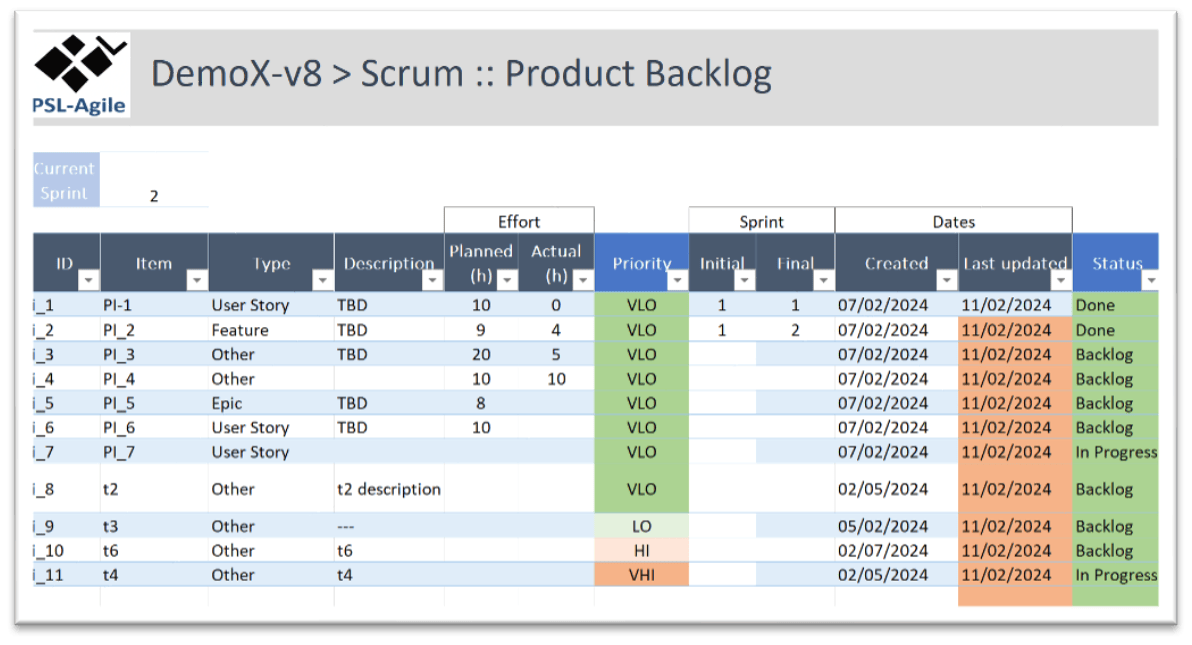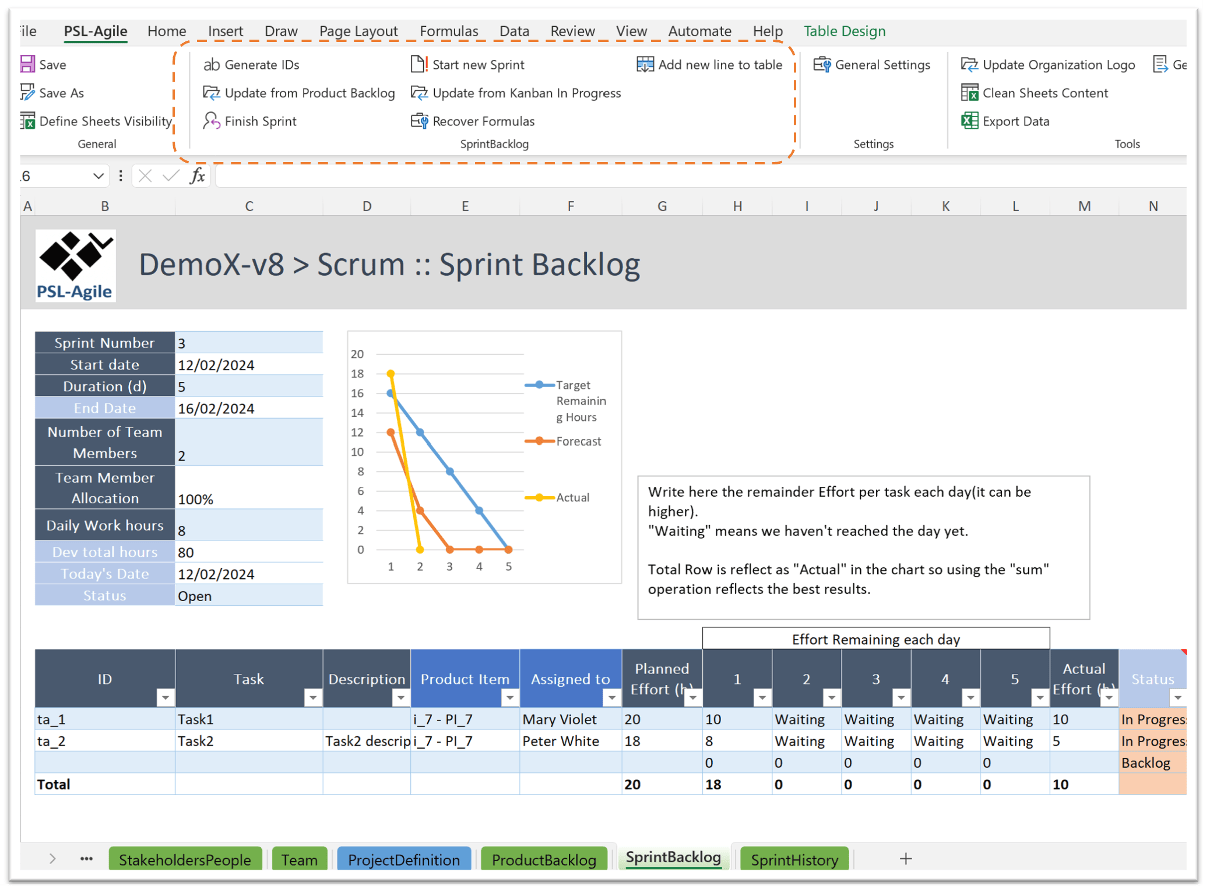This is an old revision of the document!
Table of Contents
Scrum Approach
Scrum Concepts
The Scrum approach involves key concepts crucial to manage your project successfully. Let's introduce these Scrum concepts:
Release: A release represents a significant milestone in the project, where a set of features or functionalities is delivered to the end-users or stakeholders. It often follows the completion of several sprints.
Sprint: A sprint is a time-boxed iteration in Scrum, typically lasting 2-4 weeks. During a sprint, a defined work from the product backlog is completed and made potentially shippable.
Task: A task is a specific work item that needs to be accomplished within a sprint. Tasks are usually defined in detail, have assigned team members, and contribute to fulfilling user stories or product backlog items.
Project Roles: Scrum defines specific roles within a project:
- Product Owner: Responsible for defining and prioritising the product backlog, representing the customer or stakeholders, and ensuring the team delivers value.
- Scrum Master: Acts as a servant-leader for the Scrum team, removing impediments, facilitating meetings, and ensuring adherence to Scrum principles.
- Team Member: Team members are responsible for developing and delivering the product increment during a sprint. They collaborate closely and are cross-functional.
Features: Features are high-level functionalities or characteristics of the product that provide value to the user. They are typically described in the product backlog and can be broken down into user stories or tasks.
Requirements: Requirements are detailed descriptions of the functionality, behaviour, or characteristics that a product must possess. They often serve as the basis for creating user stories.
User Stories: User stories are concise, user-focused descriptions of a piece of functionality from an end-user perspective. They are a common way of expressing requirements in agile projects and often serve as the foundation for sprint planning.
Product Backlog: The product backlog is a prioritised list of all the features, user stories, and other requirements that need to be addressed in the project. The product owner maintains it and evolves as the project progresses.
Sprint Backlog: The sprint backlog is a subset of the product backlog items selected for a specific sprint. It represents the work the team commits to completing during the sprint.
Charts: Scrum employs various charts to track project progress and visualise data:
- Burndown Chart: A graphical representation of the work remaining in the sprint or project over time. It helps teams track progress towards completing tasks.
- Burn-up Chart: This chart shows the cumulative work completed over time. It provides insights into the overall project progress.
Sprint Planning: A crucial ceremony that occurs at the beginning of each sprint. The team plans the work to be done during the sprint, selects items from the product backlog, and sets a sprint goal.
Sprint Review: At the end of each sprint, a sprint review meeting is held to demonstrate the work completed during the sprint and gather stakeholder feedback.
Sprint Retrospective: Following the sprint review, the team conducts a sprint retrospective to reflect on the sprint's successes and areas for improvement. It's an essential step in continuous improvement.
Daily Meeting: Also known as the Daily Scrum or stand-up meeting, it is a short, daily gathering where team members discuss their progress, plans, and any impediments they face. It ensures transparency and alignment within the team.
Understanding these Scrum concepts is fundamental for effective project management and collaboration within Scrum teams, ultimately leading to successful project outcomes.
Product Backlog

The Product Backlog is the heartbeat of an agile project, capturing all the features, enhancements, and bug fixes that need to be developed over time. The Product Owner plays a pivotal role in managing and prioritising this backlog to ensure that the team focuses on delivering the most valuable items first. Here's a detailed look at the Product Backlog in the PSL-Agile Excel Template.
Product Backlog Item Properties
ID: Each item in the Product Backlog is assigned a unique identification number (ID) for easy reference and tracking.
Item Name and Description: The item shall have a concise name and a comprehensive description outlining what needs to be done or achieved.
Type: The type of item is defined, distinguishing between new user stories, features, enhancements, or bug fixes.
Planned and Actual Efforts: This section measures the estimated and actual efforts required to complete the item.
- Planned (in hours): The planned time expected to be spent to complete the product item.
- Actual (in hours): The actual time spent on the item, tracked as it progresses.
Priority: The product item's priority is critical in determining when it should be worked on. It is assessed based on two criteria:
- Priority (VLo to VHi): A subjective rating indicating the item's importance, ranging from Very Low (VLo) to Very High (VHi); or
- a numerical value indicating the item's importance in a more flexible scale (e.g., 1 to 10 scale).
Sprint: This section defines the sprint-related details for the item:
- Initial: The sprint in which the item was initially planned to be worked on; and
- Final: The sprint in which the item was expected to be completed.
Dates: Tracking the timing of items is crucial for managing the project. Two dates are provided:
- Created: When the item was added to the Product Backlog; and
- Last Updated: The date when the item was last modified or updated.
Status: This field reflects the item's current state within the backlog. It can be one of the following:
- Backlog: The item is in the backlog, awaiting prioritisation;
- In-Progress: The item is actively being worked on by the development team; and
- Done: The item has been completed and meets the definition of done for the sprint.
Actions
Generate IDs: This action automatically assigns unique identification numbers to new backlog items, ensuring order and traceability.
Update from Kanban Backlog (Premium): This feature allows for seamless synchronisation between the Product Backlog and the Kanban Backlog, ensuring that items move smoothly from the Product Backlog to the development phase.
The Product Owner is responsible for curating, refining, and maintaining the Product Backlog. This responsibility involves defining new items, reviewing and updating existing ones, and continuously prioritising based on business value and stakeholder feedback. The prioritisation process is critical in agile project management, as it determines the team's focus and helps ensure that the most valuable work is addressed first.
Sprint Backlog

The Sprint Backlog in the PSL-Agile Excel Template is designed to facilitate effective sprint management. These are the key functionalities for this section: Start New Sprint; Manage Current Sprint; and Finish Sprint.
Start New Sprint
The command “Start New Sprint” (available from SprintBacklog group) enables you to initiate a new sprint with precise configuration parameters:
Sprint Number: Assign a unique number to the sprint for identification purposes.
Number of Team Members: Specify the count of team members participating in the sprint.
Start Date: Set the commencement date of the sprint.
Team Member Allocation %: Define the percentage of each team member's time allocated to this sprint.
Duration (d): Determine the duration of the sprint in days.
Daily Work Hours (h): Set the number of daily work hours for the sprint.
Keep Not Completed Tasks from Current Sprint: Choose whether to copy tasks not completed from the current sprint to this new sprint.
Sprint Backlog Item Properties
ID: Each task in the Sprint Backlog is assigned a unique identification number (ID) for tracking and reference.
Task Name and Description: A brief name and informative task description.
Product Backlog Item: Link the task to the corresponding Product Backlog Item, establishing a clear relationship.
Assigned To (Team Member(s)): Specify which team member(s) are responsible for executing the task.
Planned Effort (h): Estimate the effort required to complete the task in hours.
Remaining Effort (h): Reflect the remaining effort necessary to finish the task, updated regularly, such as at the end of each day. Write here the Remainder Effort Per Task each day (It can be higher): A field to note any additional effort required for a task on specific days. The “Waiting” status indicates that the day has not been reached yet.
Actual Effort (h): Record the actual time spent on the task, with updates made, for example, at the end of each day.
Status (Backlog (or To-Do), In-Progress, Done): Define the current status of the task within the sprint, whether it is still in the backlog, actively being worked on, or completed.
Total Row: This row calculates the “Actual” values in the chart, allowing for easy tracking and summing of efforts.
Manage Current Sprint
Table-Based Actions
Add new line (Task) to table: Insert a new task line and fill the relevant cells with task details.
Edit Task: Modify task details directly within the respective line cells, such as task name, description, or planned effort (h).
Assign Resources to Task: Assign team members to tasks by double-clicking on the “Assigned to” cell, streamlining task allocation.
Delete Task(s): Select and delete specific task lines as needed, maintaining a clean and organised Sprint Backlog.
Ribbon Actions
Generate IDs: Automatically assign unique identification numbers to new tasks, ensuring orderly tracking.
Update from Kanban in Progress (Premium): Sync task progress with the Kanban In-Progress section, ensuring accurate and up-to-date information.
Update from Product Backlog (Premium): Streamline task management by updating tasks directly from the Product Backlog.
Finish Sprint
When the current sprint concludes, you can utilise the “Finish Sprint” command (a ribbon action). This action transitions the sprint's status to “Closed”, and all related sprint backlog items are moved to the “SprintHistory” worksheet. This archival process is crucial for future reference, analysis, and retrospective assessments of completed sprints.
